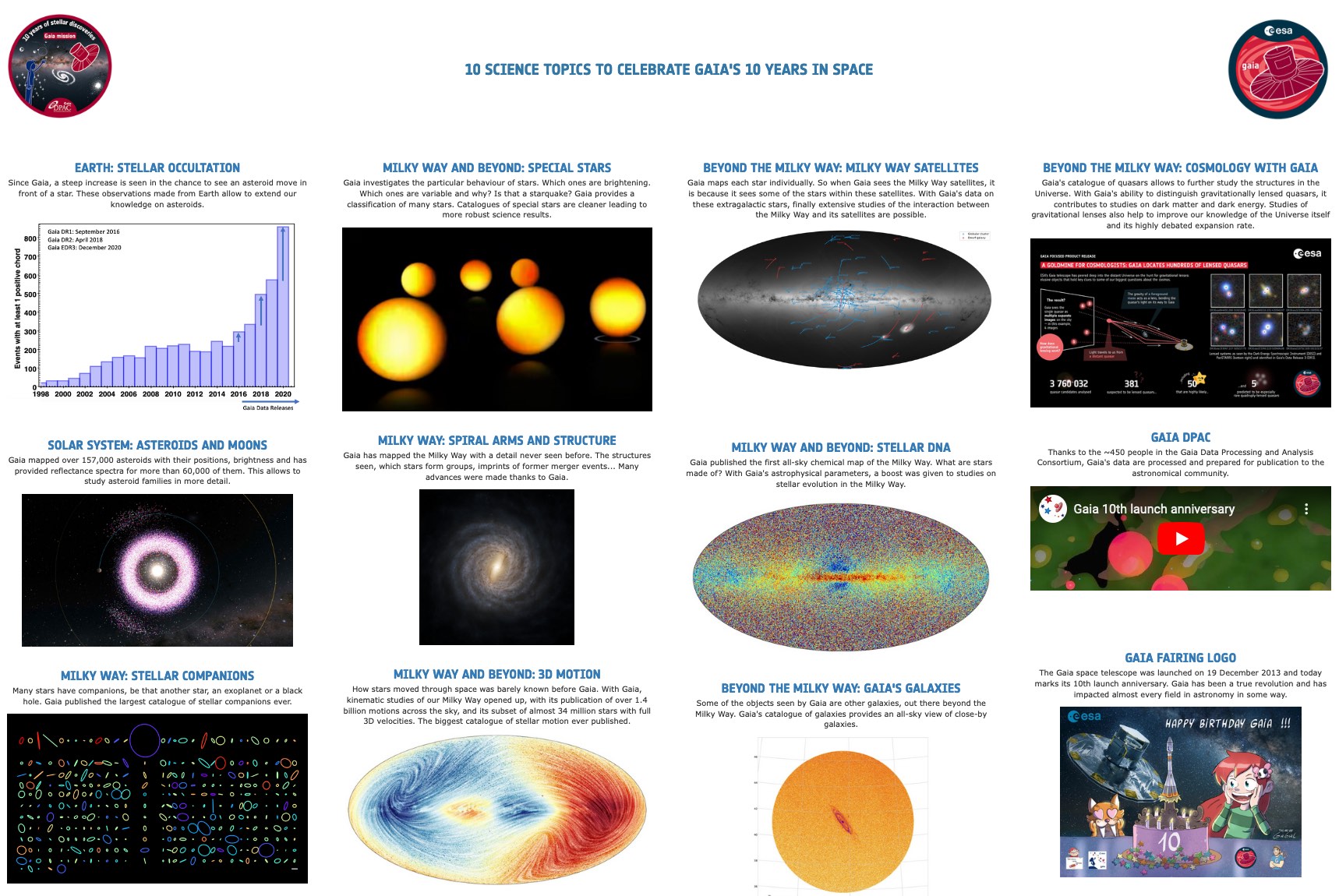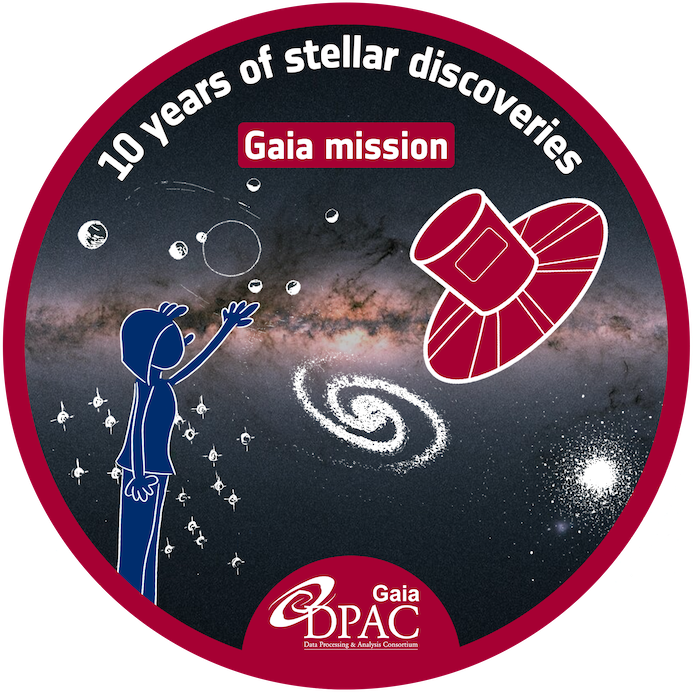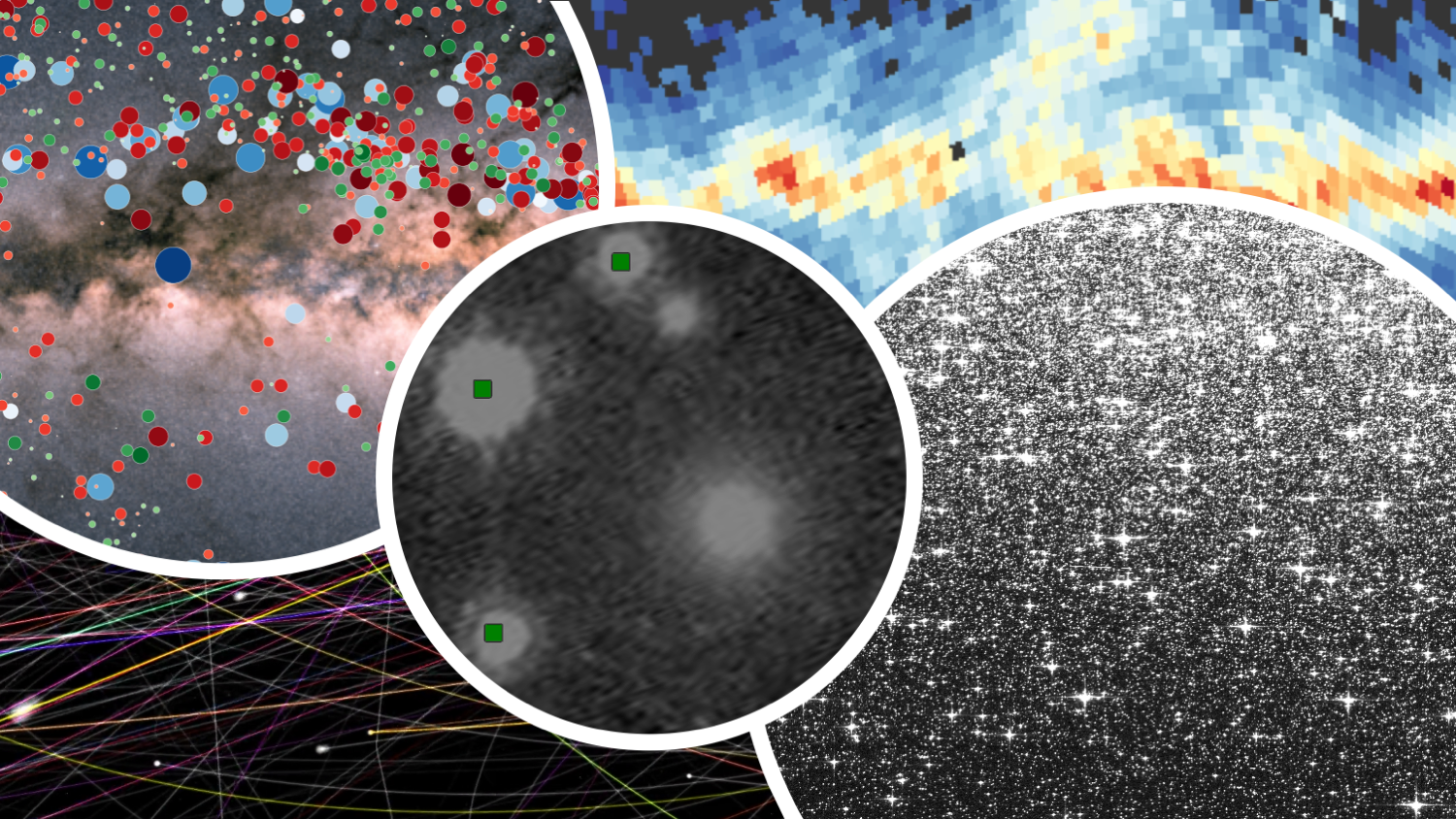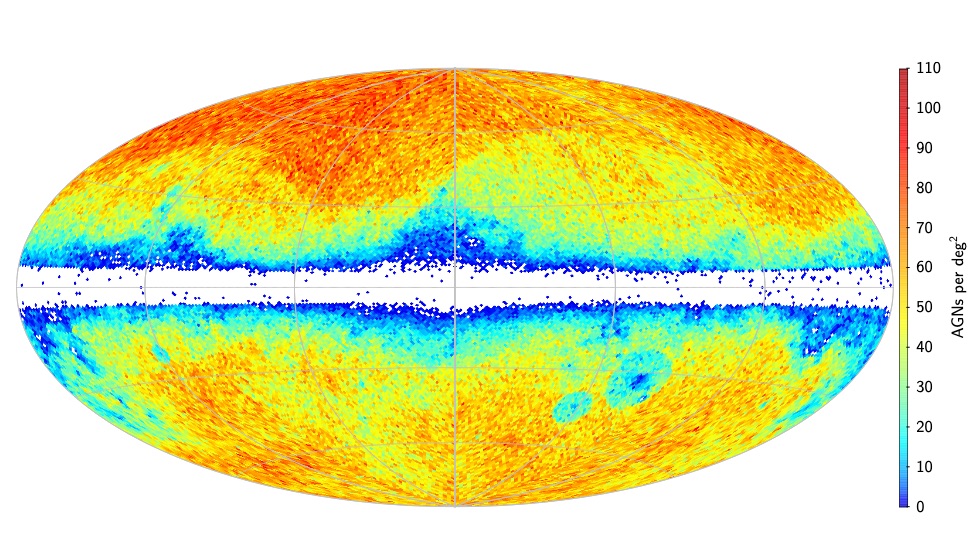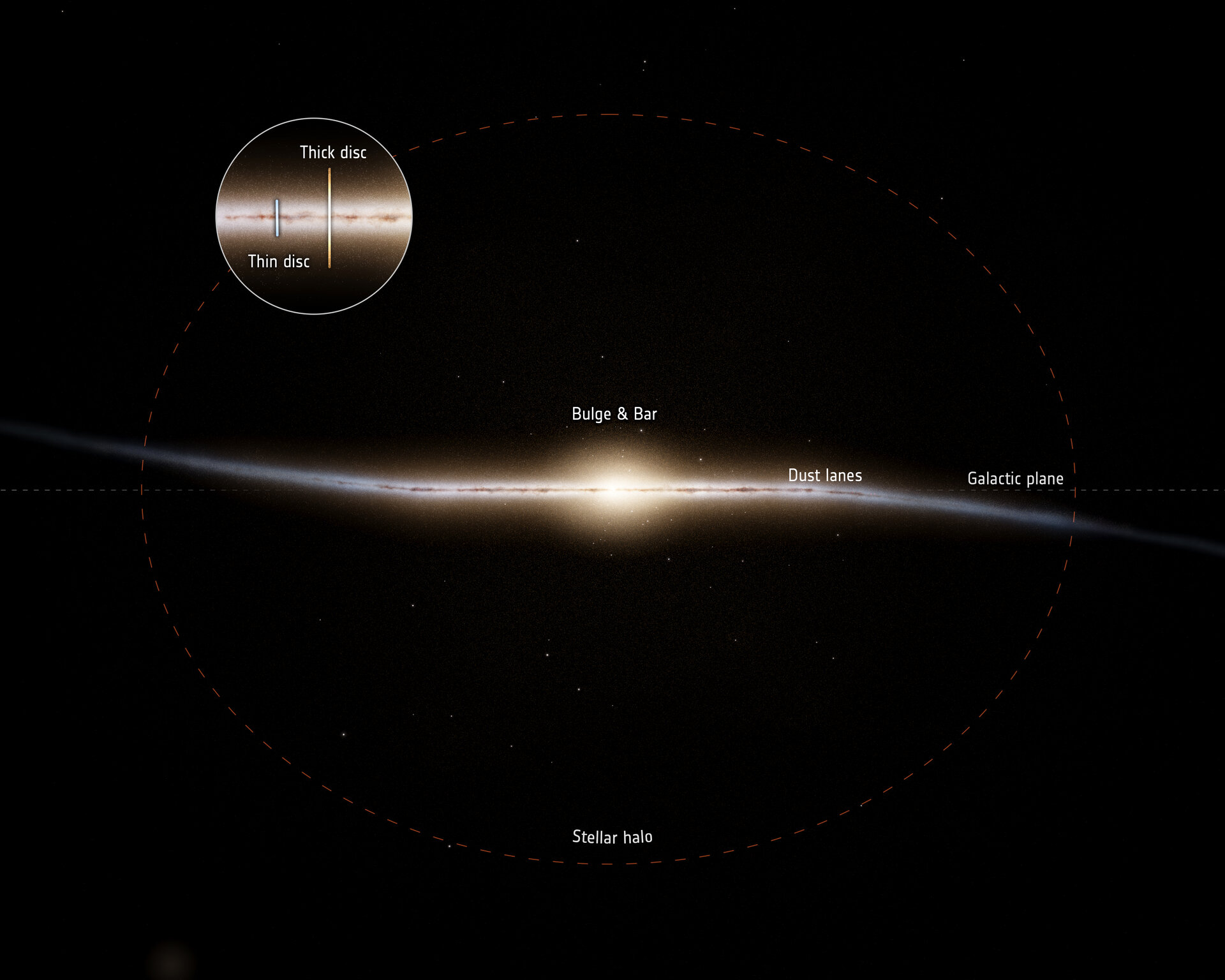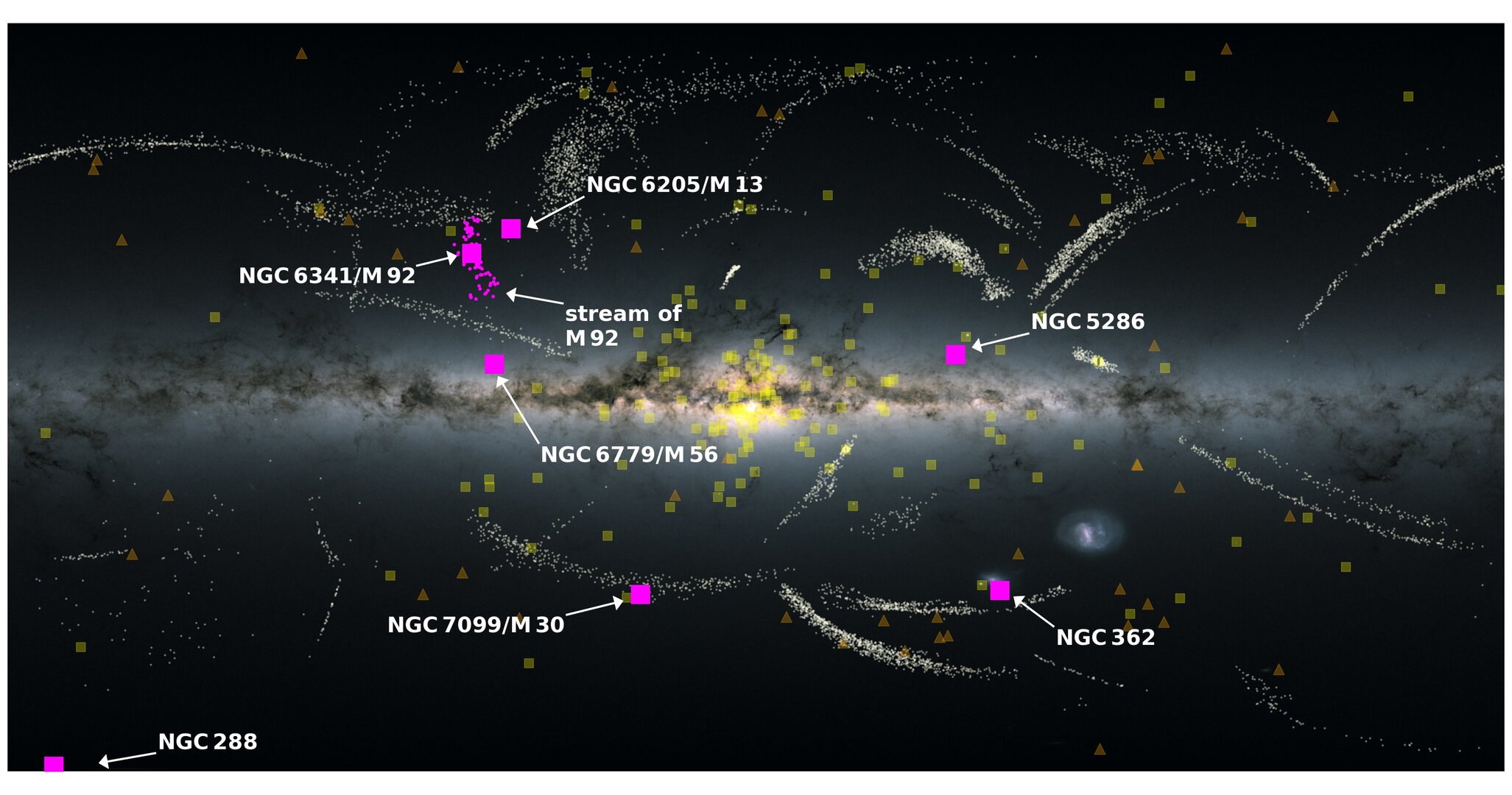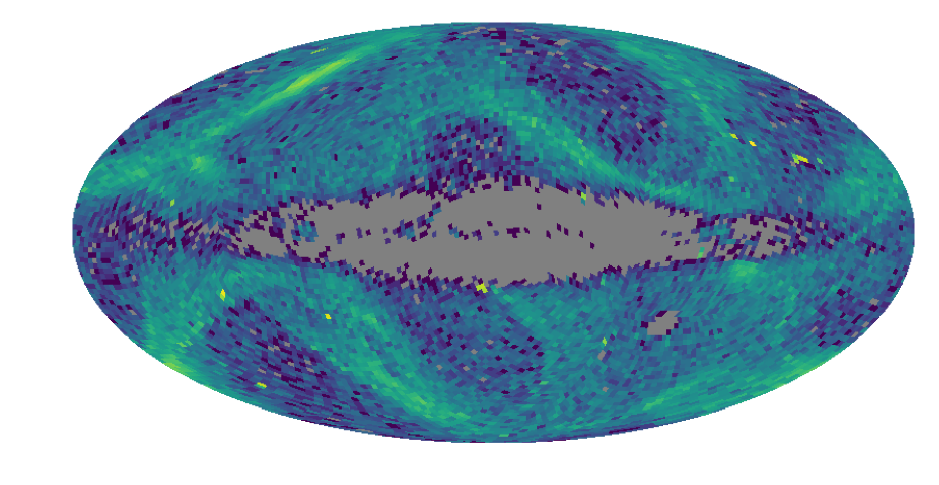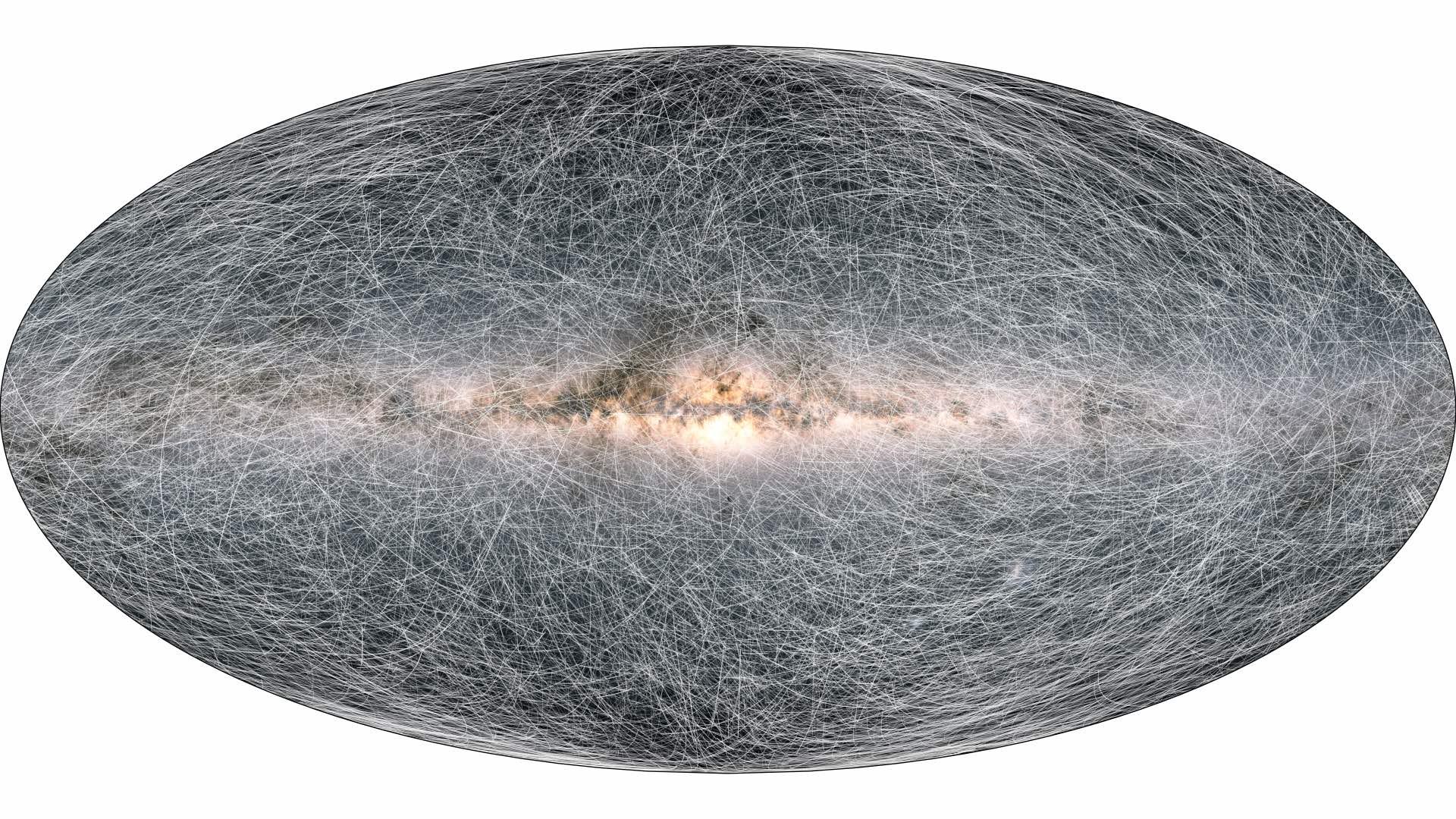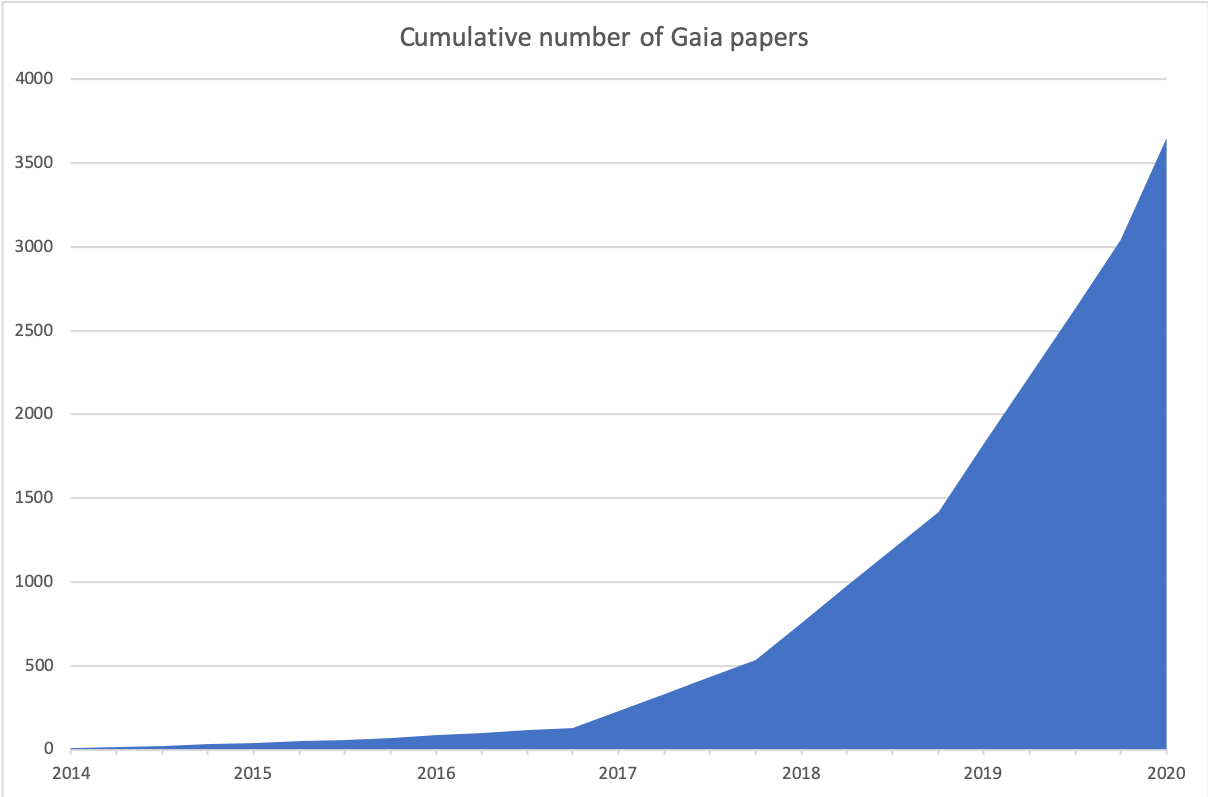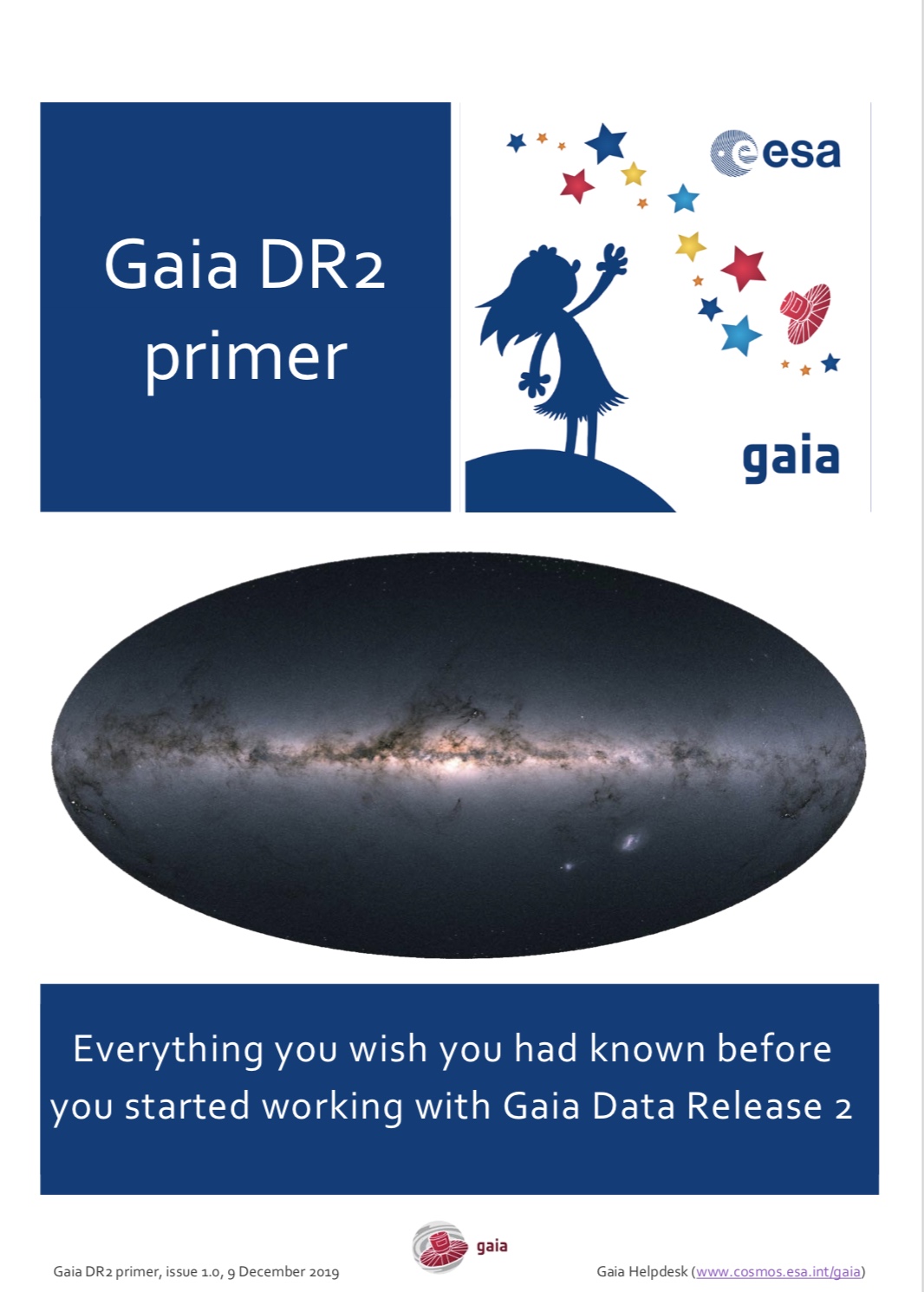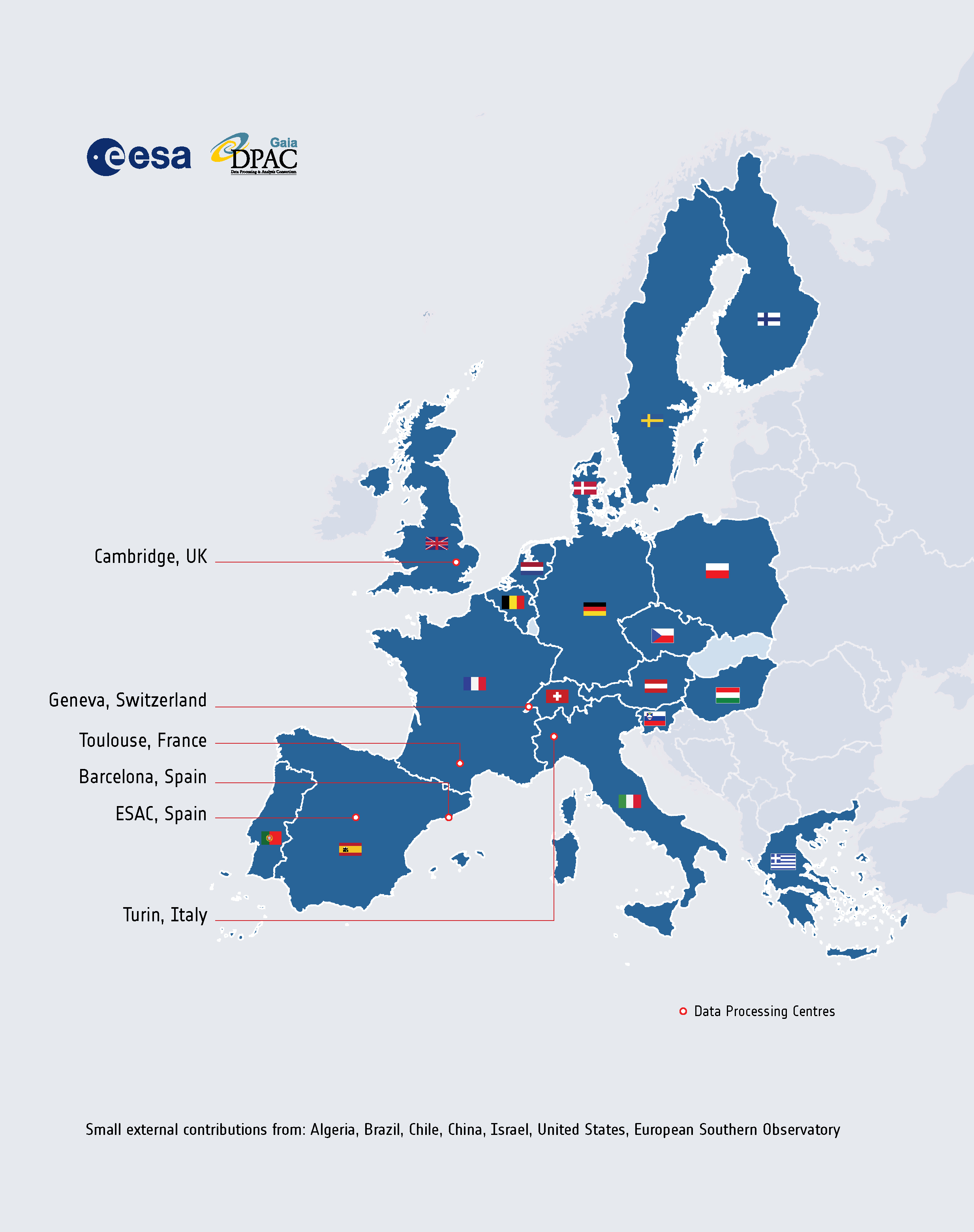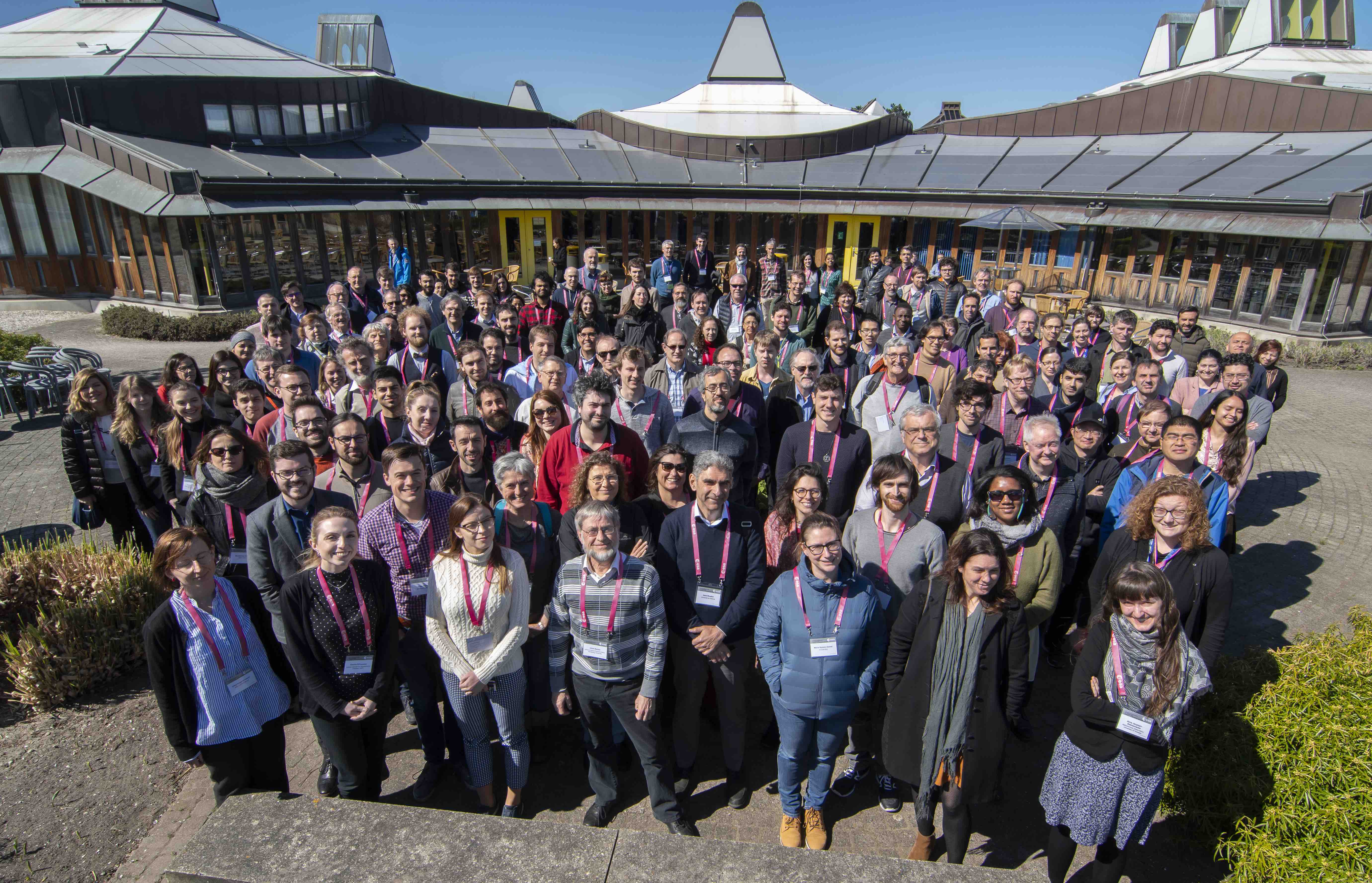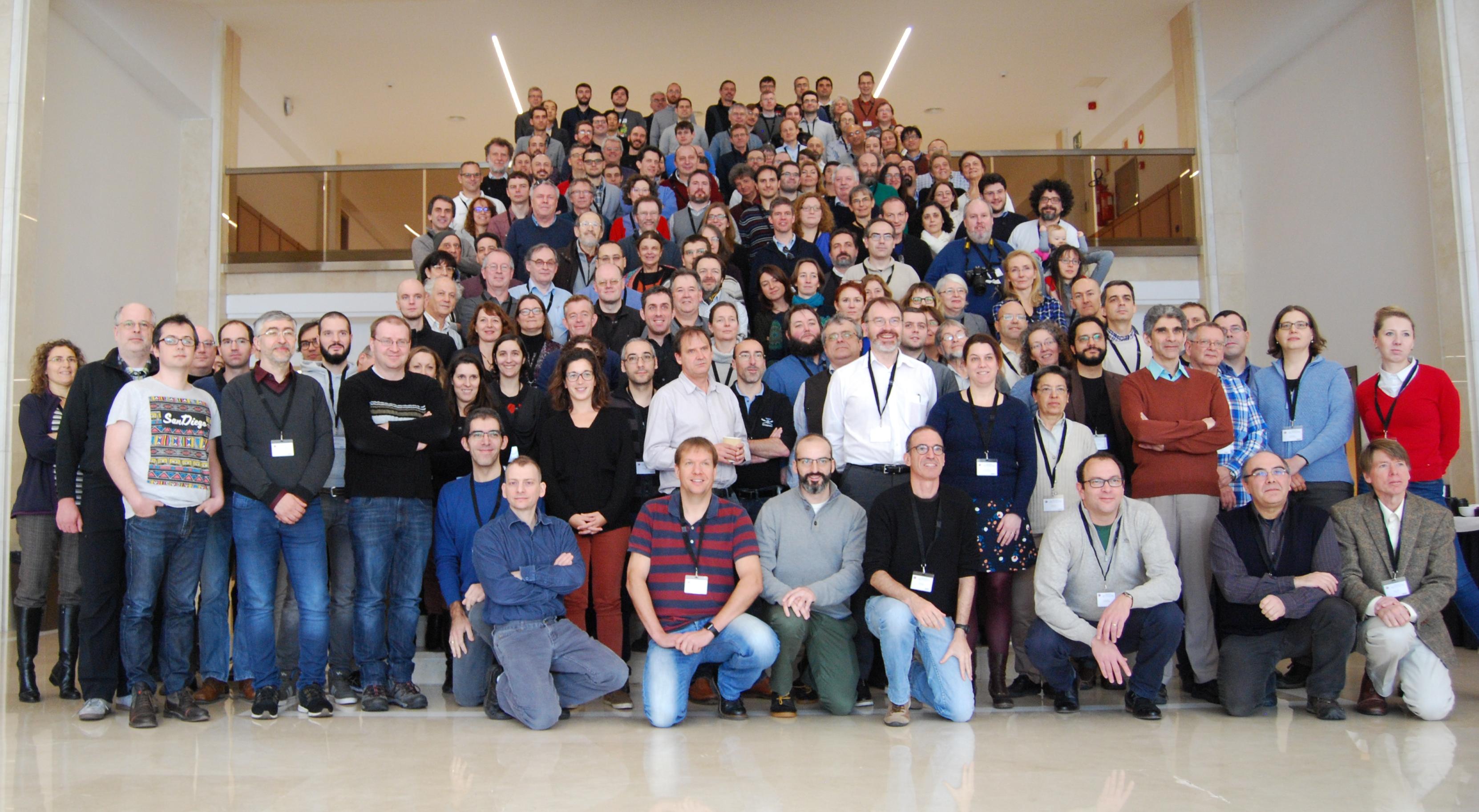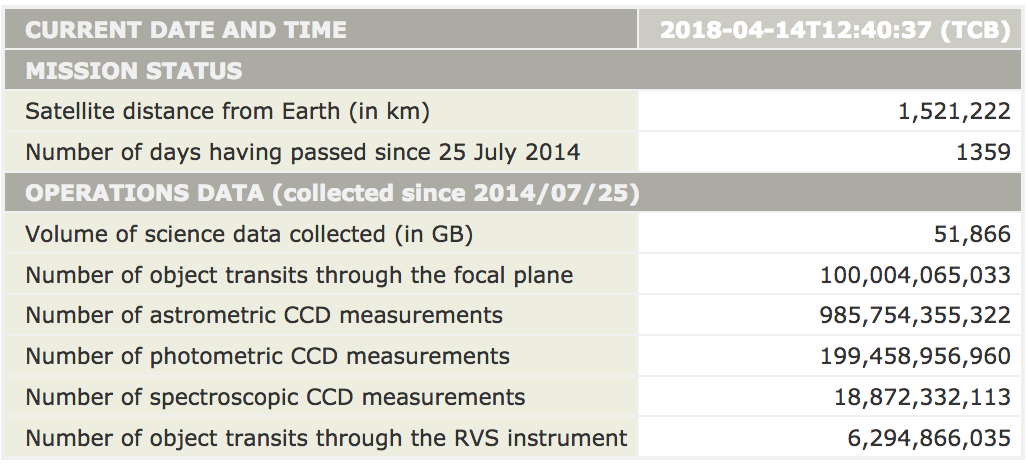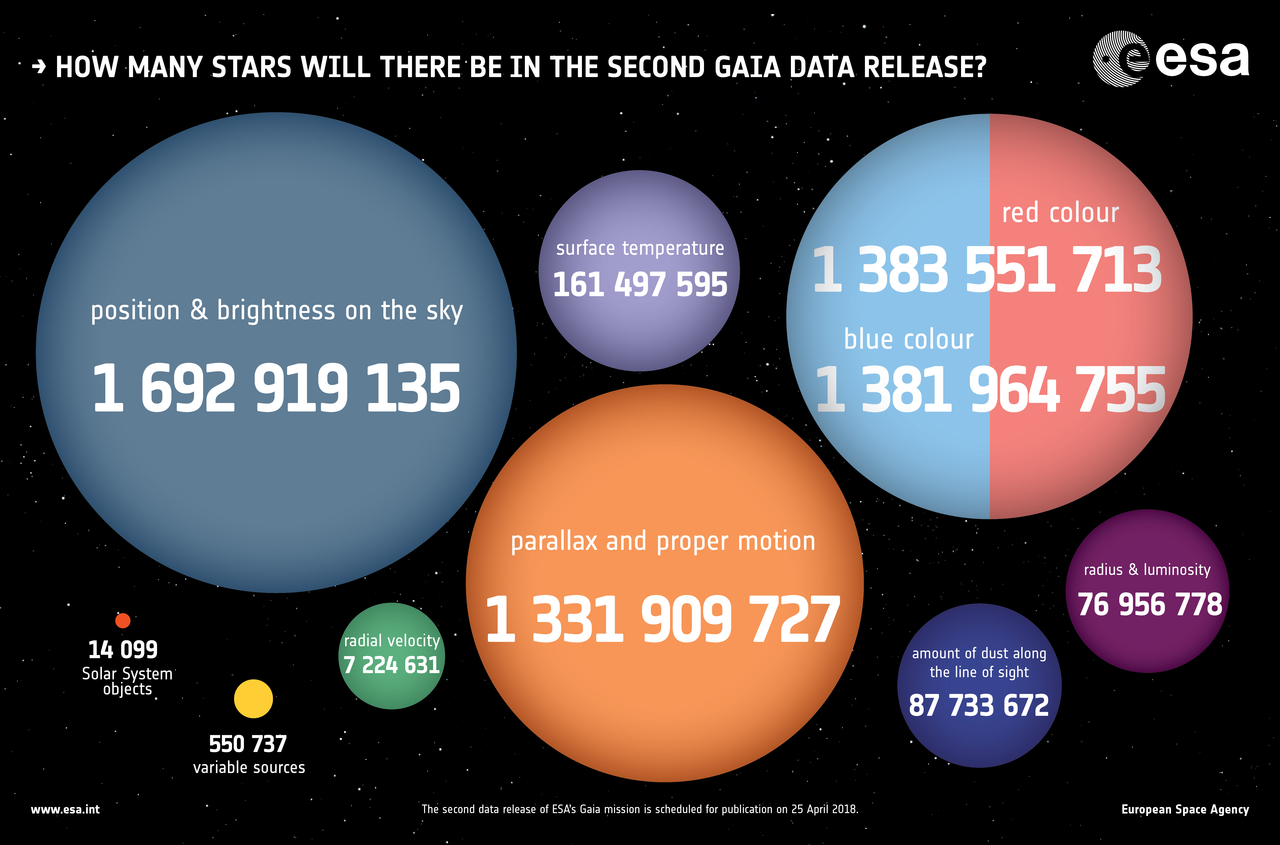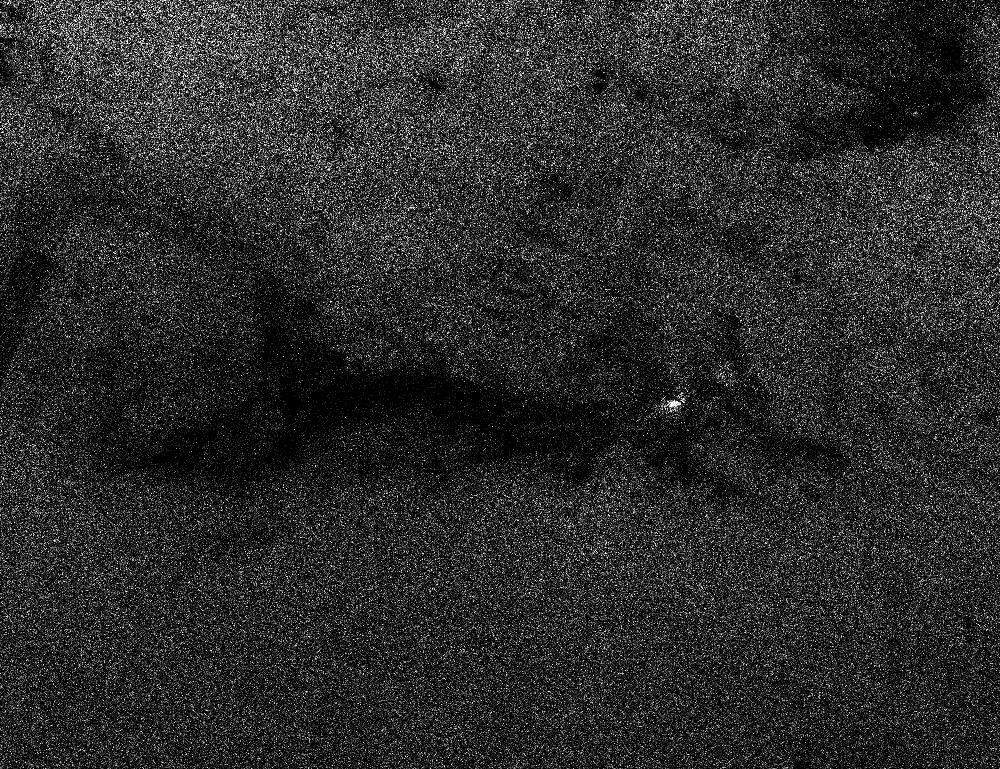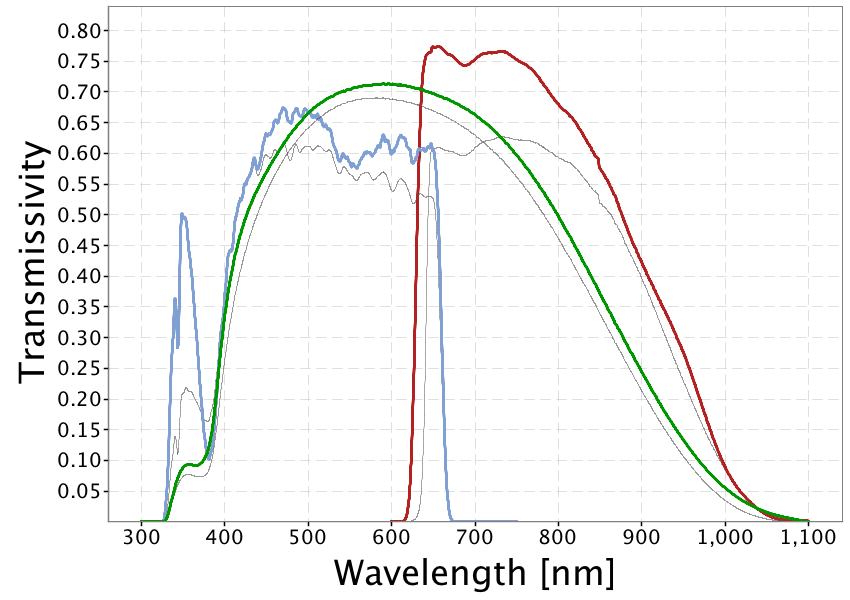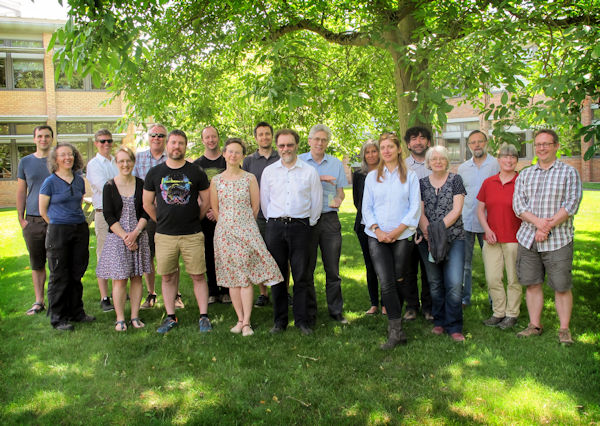Gaia Mission News - Gaia
Gaia News
2024-04-16 Sleeping giant surprises Gaia scientists
Gaia finds the most massive stellar black hole in our Milky Way. Gaia BH3 has a mass of 33 solar masses, is the second closest black hole to Earth now at approximately 2000 light years away and is part of a wide binary system with an old giant star, estimated at an age of 11 billion years. Read more in the story published on esa.int/gaia: https://www.esa.int/Science_Exploration/Space_Science/Gaia/Sleeping_giant_surprises_Gaia_scientists .
2024-04-15 Upcoming press release on intermediate Gaia Collaboration paper
Tomorrow morning, Tuesday 16 April 2024, ESA as well as many institutes from the Gaia Data Processing and Analysis Consortium will publish a press release related to an intermediate Gaia Collaboration paper. Keep posted!
The Gaia Data Processing and Analysis Consortium is currently processing and validating the data that will be published in Gaia Data Release 4, which is not expected before the end of 2025. The latest updates for the Gaia Data Release scenario are always published from this page.
2024-04-11 PhD thesis prize of the French Astronomical Society awareded to Gabriele Contursi, Gaia DPAC member
We are proud to announce that the PhD thesis prize of the French Astronomical Society has been awarded to our Gaia Collaboration member: Gabriele Contursi. Congratulations from Gaia!
Gabriele Contursi completed his thesis in October 2023 at the Lagrange Laboratory of the Côte d'Azur Observatory, under the supervision of Patrick de Laverny. His work focused on the production of s-elements in the Milky Way by analysing spectroscopic data collected both from the ground and from space, thanks to the Gaia mission. Gabriele was a member of the CU8/GSP-spec module and contributed to the analysis of the millions of stellar spectra collected by the Gaia RVS instrument, resulting in an essential contribution to the third data release. More specifically, Gabriele built the GSP-spec spectral line list adopted by GSP-spec. Then, Gabriele used the Gaia DR3 GSP-spec data to study the Ce content in various Galactic stellar populations, as well as the abundances of the Nd and Ce at the surface of asymptotic giant branch stars. In addition to the quality and impact of his work for the community, the SF2A board also highlights the exceptional quality of his thesis manuscript.
2024-04-11 Larger downtime of Gaia ESA Archive and several Gaia systems in use by the Gaia collaboration expected
Following major building renovation work at the European Space Astronomy Centre (ESAC), we will be moving our data centre containing all our IT hardware infrastructure. We understand the inconvenience this may cause and sincerely apologize for this downtime. We’ve taken this opportunity to improve our data centre infrastructure to significantly increase its reliability and its energy efficiency. Our teams will be working hard to resume all our services as soon as possible, once the move is complete.
IMPORTANT: Many of our services, including the Gaia ESA Archive, will be down from 18 April 17:30 CEST until 23 April 08:30 CEST.
More details:
- On 17 April at 12:00 CEST systems affecting the Gaia Collaboration will be stopped: Nexus and SVN, to allow for backups to be in place before the migration starts.
- On 17 April at 17:00 CEST systems affecting the Gaia Collaboration and depending on databases will be stopped. This will include many of the CU1 tools like MDBdictionary and GOST tools.
- On 18 April at 17:00 CEST applications affecting the communication with the Gaia Collaboration will be stopped. Gaia mailing lists will stop working and emails send during the downtime period should not be considered sent and should be resend on the 23rd of April to ensure their arrival.
- On 18 April at 17:30 CEST applications affecting the Gaia Collaboration will be stopped: Jira, Wiki, Helpdesk, Confluence, etc.
- On 18 April at 17:30 CEST the Gaia Archive will go down.
- On 23 April at 08:30 CEST systems will be back up. Some systems might need some extra time to be brought back up. Don't be alarmed if a system is not immediately responsive on the 23rd. If you still encounter issues with systems by 23 April evening, then please inform the Gaia helpdesk so we can look into it.
Certain systems and websites will remain available, among which Gaia cosmos, Gaia help pages and Gaia content server.
The Gaia helpdesk will remain active as an email inbox only. You can reach us at our helpdesk email address: gaia-helpdesk at esa.int
2024-03-26 New Gaia Archive GACS release today
Today the Gaia Archive has been patched and the latest version of GACS is now 3.5.3. Find full details on the patches performed from the Gaia Archive release notes. Version 3.5.3 contains among others the following general improvements (for full details with complete overview of updates and patches be referred to the release notes):
- Archive Web Interface (GUI): The Single Object Tool now includes a new ESASky selector plugin.
- TAP service: Addition of reference epoch and positional fields to the positional catalogues in the Gaia FPR: crowded_field_source, lens_candidates, lens_observation, lens_outlier.
- DataLink service: The "source_id" field can now be used to retrieve DataLink products via VO-clients like TOPCAT thanks to the updated Service Descriptors generated by the Archive.
- Astroquery: JSON files can be downloaded.
- ADQL 2.1: Several User Defined Functions (UDFs) are now available (see also the "IVOA-endorsed UDFs" section in the ADQL: Implementation in the Gaia ESA Archive tutorial)
- Tutorials (new and/or updated): Gaia Collaboration queries updated with different use cases related to the astrophysical_parameters and astrophysical_parameters_supp tables.
- External catalogues: Added CatWISE2020 external catalogue and Gaia-ESO Survey (data release 5.1) external catalogue.
2024-03-21 Gaia unravels the ancient threads of the Milky Way
ESA’s Gaia space telescope has further disentangled the history of our galaxy, discovering two surprising streams of stars that formed and wove together over 12 billion years ago. The two streams, named Shakti and Shiva, helped form the infant Milky Way. Both are so ancient they likely formed before even the oldest parts of our present-day galaxy’s spiral arms and disc. Read more in the story published on esa.int/gaia: Gaia unravels the ancient threads of the Milky Way
2023-03-18 Gaia maps largest ever collection of quasars in space and time
Astronomers have created the largest yet cosmic 3D map of quasars: bright and active centres of galaxies powered by supermassive black holes. This map shows the location of about 1.3 million quasars in space and time, with the furthest shining bright when the Universe was only 1.5 billion years old. Read more in the story published on esa.int/gaia: https://www.esa.int/ESA_Multimedia/Images/2024/03/Gaia_maps_largest_ever_collection_of_quasars_in_space_and_time
2024-03-06 Gaia Symposium at the European Astronomical Society
On 1 and 2 July, a symposium dedicated to Gaia's Two Billion Star Galaxy Census is organized, dealing with subjects from the Solar System to the Milky Way and beyond. More details on this symposium can be found here.
2024-03-05 Graduate Trainee positions at ESA
The ESA graduate trainee positions for 2024 have been published. Applications for the position "Young Graduate Trainee in Machine Learning & Accessibility for Space Science" are welcome. Deadline for applications is 7 March 2024.
2024-03-06 Astrometry focus meeting at the IAU General Assembly 2024
This year's International Astronomical Union (IAU) General Assembly features a focus meeting on Astrometry (14-15 August 2024) in Cape Town, South Africa. The Focus meeting website is online at https://sarao.ac.za/iau_fm11/. The General Assembly is open for early registration at https://astronomy2024.org/registration/.
The objectives of the Focus Meeting are described below:
The field of astrometry is in a golden era with spectacular progress at multiple wavelengths thanks to the massive progress made with the Gaia mission in both the number of objects and precision of its optical astrometry survey. Spectacular progress is also being made with ground-based optical interferometry such as the Very Large Telescope’s GRAVITY instrument and other extremely large aperture optical telescopes. In the radio, rapid progress is being made in simultaneous 4-wavelength instruments such as the Korean (22-129 GHz), VGOS (3-10 GHz), and JPL (8-36 GHz) VLBI systems. Many new instruments are emerging with broad wavelength coverage and increased sensitivity such as the SKA and next-generation VLA. High-accuracy astrometric data is now used across a number of astronomy disciplines and in solar system science as well as mission-enabling disciplines such as spacecraft tracking.The 2024 IAU GA in South Africa is the natural venue to bring these communities together.
Focus meeting 11 aims to bring together the practitioners and users of high accuracy astrometric data in order to inform the community on recent scientific successes in astrometry, to educate the community on advances in astrometric techniques across different wavelength ranges and instrument concepts, and to inspire future advances.
In particular, we aim at bringing together the various astrometry communities (Optical/IR, radio, ground and space-based surveys, specialized astrometric instruments) which often work in relative isolation from each other. The Focus meeting will promote understanding of the complementarity of the various branches of astrometry and thus reveal synergies between the different astrometric techniques thereby driving the definition of future directions for our discipline. We note that as the first IAU GA in Africa, this meeting provides an excellent opportunity to encourage greater interactions with our African colleagues. We seek to highlight African instruments coming into focus such as the SKA, the African VLBI Network (AVN), and the proposed Namibia and Kilimanjaro mm telescopes.
2023-12-19 Gaia celebrates 10 years in space!
Having been launched on 19 December 2013, Gaia has now spent 10 years in space! Today we celebrate these 10 amazing years with 10 science topis, starting with Gaia's impact on Earth with stellar occultation, and moving out into the Solar System and further into the Milky Way and beyond. Gaia has impacted almost every field in astronomy, with data releases based mostly on its first 34 months of observations. Exciting new data is expected with Gaia's data release 4 which will cover 66 months of observations!
2023-12-14 Gaia's 10 years in space kick off with a celebratory logo
10, 9, 8, 7, 6, 5... days left to ESA Gaia's 10 years in space. Let's start the celebrations with this special Gaia Mission logo designed by Mariasole Agazzi and Albert Masip Vela in collaboration with Rosanna Sordo and Federico di Giacomo, members of the Gaia Data Processing and Analysis Consortium. More coming up in the following days... keep tuned!
2023-10-31 Gaia scanning law published for the full operational mission period
The Gaia scanning law pointings for the data collection period underlying Gaia (E)DR3 are available from the Gaia ESA Archive in a table named "gaiadr3.commanded_scan_law". Here we provide an additional and complementary data set, namely the commanded scanning law pointings over the full mission interval (from 2014-07-25 10:31:26 TCB to 2025-06-30 23:59:56 TCB), including the Ecliptic Pole Scanning at the beginning of the mission. As in the case of the Gaia (E)DR3 table, the data presented here contains the attitude as commanded in the past and as currently planned to be commanded in the future. The actually realised attitude of the spacecraft could deviate from it by up to about 30 arcsec. The time interval, in particular the end date in summer 2025, is excepted to contain the full operational mission period. Obviously, the precise end of spacecraft operations is not yet defined. Find full details here.
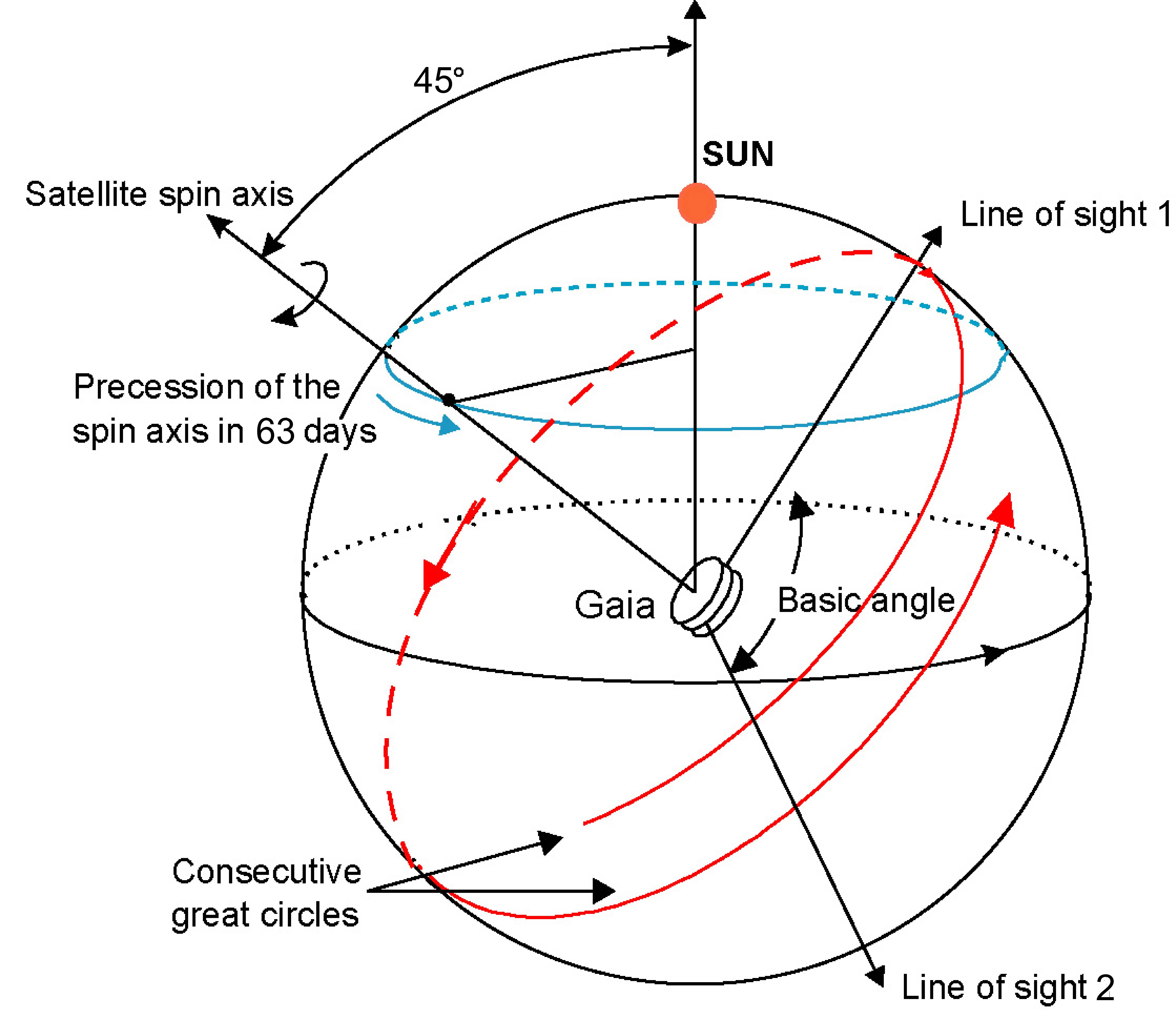
Selection of some interesting news from past years
full overview of news per year For operational phase can be found here:
2024 2023 2022 2021 2020 2019 2018 2017 2016 2015 2014
Full overview of news per year for study phase / building of the spacecraft / launch can be found here:
2013 2012 2011 2010 2009 2008 2007 2006 2005 2004 2003 2002 2001
2023-10-13 Gaia Focused Product Release is out!
On 10 October 2023 Gaia published its Focused Product Release. On the overview page, links to all relevant information related to this release are provided. The documentation for this release is covered mostly by the Gaia Focused Product Release papers, for which links are available from the Gaia FPR papers page. The data release documentation is complementary to the papers and is available as PDF and through our webpages. Please be aware of a few known issues published for the solar system objects.
The data is available from the Gaia Archive and our partner data centres.
Full overview of the data products and their applications is given in our Gaia FPR stories. One story per data product has been published. A press release was prepared by ESA Communications and is available from this webpage. More press releases were written by Gaia DPAC institutes, these press releases are available from the Gaia FPR events page.
On 10 October and the few days following the release, several events were organized across Europe and in Brazil. Some of these events were recorded, and the recordings have been made available from our events page.
2023-08-28 Gaia DPAC Solar System Objects team honoured by the "Asteroid Comet Meteorites" Science Organization Committee
On 21 June 2023, the Asteroid Comet Meteorites SOC honoured the collaborators of the Solar System Objects (SSO) team of the Gaia Data Processing and Analysis Consortium. They did so with asteroid nominations, naming 4 asteroids after members of the Gaia DPAC SSO team.
- (30264) Galluccio
- (32607) Portell
- (33437) Ordenovic
- (35623) Pedrodavid
Full citation and details can be found from the last bulletin of the IAU working group for small body names.
2023-08-24 Gaia mission news
Gaia continues to operate nominally toward its 10th launch anniversary on 19 December this year. The current estimate of the remaining lifetime is about 1.5 years. In the first quarter of 2025 Gaia is expected to run out of cold gas, the gas used to maintain its highly precise scanning attitude.
Data processing performed by Gaia DPAC is progressing nominally toward Gaia DR4
2023-08-11 How Gaia helps measure space weather
Yesterday a story was published by ESA Enabling & Support about Solar System fingerprints found in memories of ESA flotilla. Gaia's engineering data can be used to measure the space weather at L2. A paper discussing this topic has been published: "Solar Energetic Particle Events Detected in the Housekeeping Data of the European Space Agency's Spacecraft Flotilla in the Solar System".
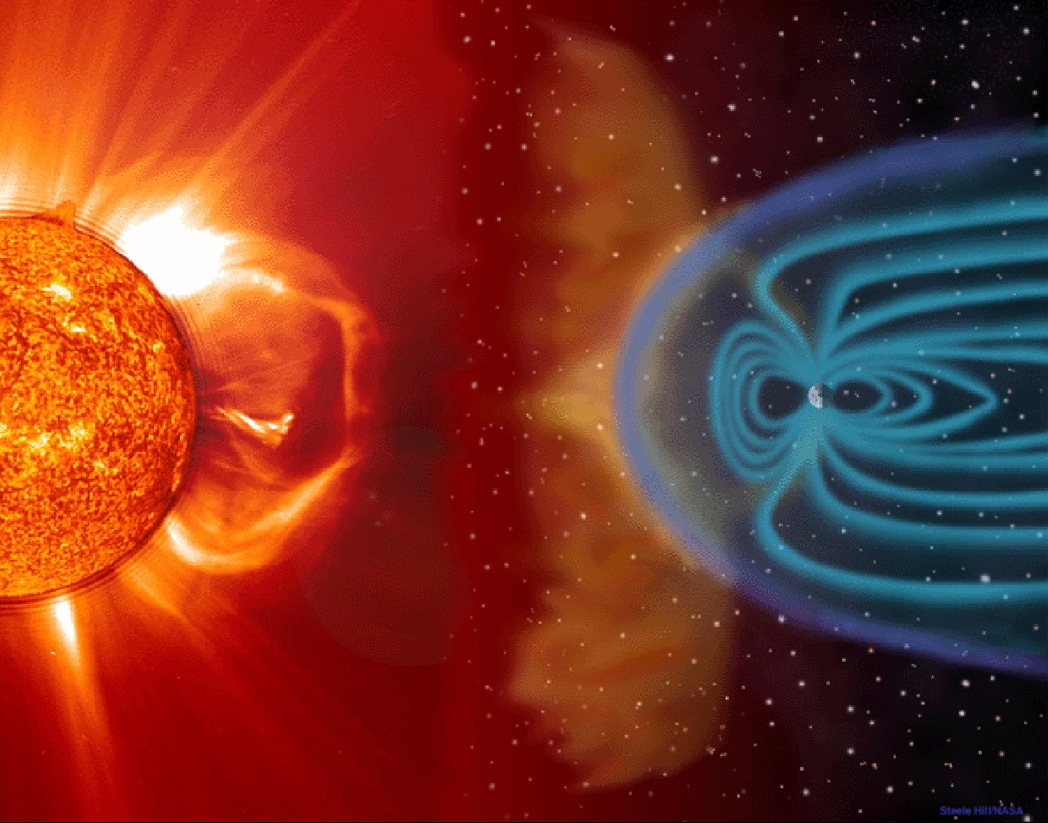
This composite image shows a SOHO image of the Sun and an artist's impression of Earth's magnetosphere. Source Copyright: Magnetosphere: NASA, the Sun: ESA/NASA - SOHO
2023-05-26 Gaia Focused Product Release planned for 10 October 2023
Gaia's data release scenario page has been updated with the planned date for publication of the Gaia Focused Product Release. Save the date: Tuesday 10 October new Gaia data will become available.
The Focused Product Release will be consisting of:
- Updated astrometry for Solar System objects.
- Astrometry and photometry from engineering images taken in selected regions of high source density (only Omega Cen for this FPR).
- The first results of quasars' environment analysis for gravitational lenses search.
- Extended radial velocity epoch data for Long Period Variables.
- Diffuse Interstellar Bands from aggregated RVS spectra.
Each data product in this Focused Product Release will be accompanied by a Gaia Collaboration paper. More information on the expected contents of this Focused Product Release will be published soon.
2023-05-08 Team Achievement Award for the Gaia mission
The Gaia misson won the 2019 ESA DG Team Achievement Award. Celebrations were delayed due to the pandemic and took place today on 8 May 2023. A space mission is constructed and thought through by many people, from industry to the science community and ESA, from engineers to financial and IT. Together we make it happen!
2023-03-13 6th DPAC consortium meeting kicks off
Gaia's Data Processing and Analysis Consortium is responsible for the transfer of the Gaia raw data into Gaia scientific data products, made available from the Gaia archive and its partner data centres as data releases. The consortium consists of more than 450 scientists, engineers and software developers from across Europe and beyond. Due to the pandemic, meeting in person with a large fraction of the collaboration was not possible in the past few years. Today, the 6th Gaia DPAC consortium meeting kicks off and promises to bring a full week of preparations for Gaia's Focused Product Release (planned in Q4 2023) and Gaia's Data Release 4 (not expected before the end of 2025).
2022-11-09 Gaia Collaboration to receive 2023 Berkeley Prize
The Gaia collaboration is being honored with the 2023 Lancelot M. Berkeley − New York Community Trust Prize for Meritorious Work in Astronomy for enabling a transformative, multidimensional map of the Milky Way. Since its launch in 2013, the European Space Agency’s Gaia space telescope has recorded stellar positions, distances, colors, and proper motions for nearly two billion stars in our galaxy. According to the prize statement, “Gaia’s three data releases will long be regarded as major events in the history of astronomy, triggering a global partnership to better understand the origin, structure, and destiny of our home galaxy.”
Full details in the announcement here: https://www.cosmos.esa.int/web/gaia/news/2022-11-09-gaia-collaboration-to-receive-2023-berkeley-prize
2022-10-21 Three stories featuring the Gaia mission published across ESA websites
In the past two weeks, three stories featuring the Gaia mission were published across ESA websites. The first one is about stellar occultations, made possible with Gaia's exquisite star data: "Shadow hunters capture Didymos asteroid eclipsing stars" published by ESA Enabling & Support. The second one is the surprising detection of a gamma-ray burst by Gaia and many other ESA spacecraft: "ESA spacecraft catch the brightest ever gamma-ray burst" published by ESA Science & Exploration. The third one discusses near-Earth asteroids and how Gaia helps to improve their orbits: "30 000 near-Earth asteroids discovered and rising" published by ESA Space Safety.
2022-09-23 Shaw Prize award ceremony
In May 2022 it was announced that the Shaw Prize in Astronomy was awarded to Lennart Lindegren and Michael Perryman, for their "lifetime contributions to space astrometry, and in particular for their role in the conception and design of the European Space Agency's Hipparcos and Gaia missions."
Lennart Lindegren and Michael Perryman led the proposal for the Gaia Mission in 1993. Lennart Lindegren is a Professor Emeritus of Lund Observatory in Sweden, and is still active in the Gaia Data Processing and Analysis Consortium, more specifically on the Astrometric Global Iterative Solution. Michael Perryman is currently Adjunct Professor at the University College Dublin in Ireland and was Study Scientist and later Project Scientist for the Gaia mission in the period from 1995 to 2006.
More information on the awarded Shaw Prize can be found in this press release by the IAU and in this announcement by the Shaw Prize.
The Shaw Prize award ceremony will be livestreamed on 29 September through:
- The Shaw Prize website: www.shawprize.org
- The Shaw Prize Facebook page: www.facebookcom/ShawPrize
- The Shaw Prize YouTube Channel: www.youtube.com/user/ShawPrize
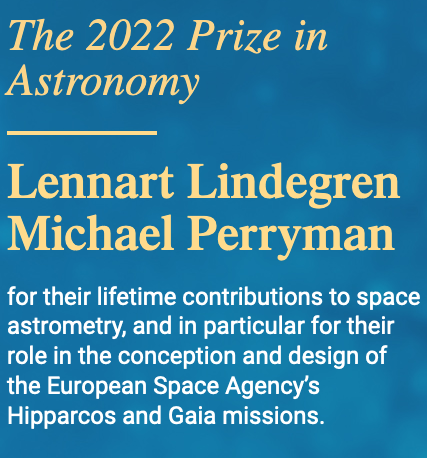
2022-08-11 Gaia reveals the past and future of the Sun
Published now on esa.int/gaia a new story on Gaia's solar analogues, giving insight in the possible past and future of the Sun.
We all wish that we could sometimes see into the future. Now, thanks to the very latest data from ESA’s star mapping Gaia mission, astronomers can do just that for the Sun. By accurately identifying stars of similar mass and composition, they can see how our Sun is going to evolve in the future. And this work extends far beyond a little astrophysical clairvoyance.
Read the full story here.
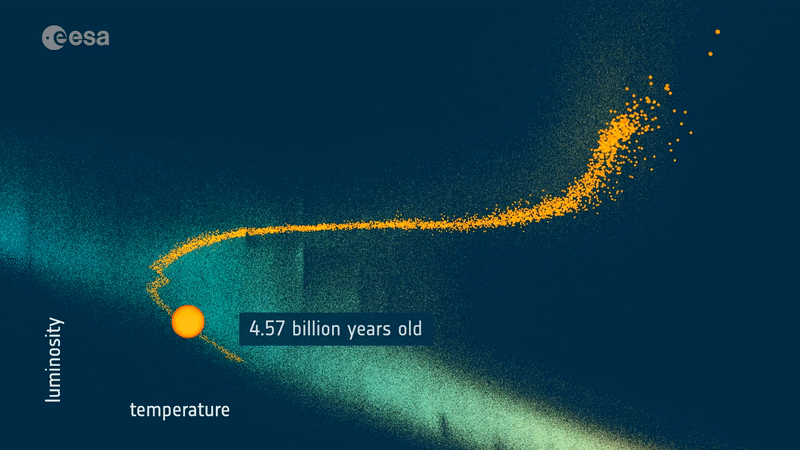
2022-06-07 Jupiter’s moon Europa to obscure distant star
Latest story published by ESA on the stellar occultation by Europa on 19 June 2022. More details can be found here: https://www.esa.int/Science_Exploration/Space_Science/Gaia/Jupiter_s_moon_Europa_to_obscure_distant_star.
2022-05-31 Media invitation for Gaia DR3 press briefing
ESA published today its invitation to the media for the Gaia DR3 press briefing on 13 June between 10:00 and 11:00 CEST. A media kit detailing the contents of the release has been published as well.
2022-05-25 Shaw prize for Lennart Lindegren and Michael Perryman
Yesterday, it was announced that the Shaw Prize in Astronomy was awarded to Lennart Lindegren and Michael Perryman, for their "lifetime contributions to space astrometry, and in particular for their role in the conception and design of the European Space Agency's Hipparcos and Gaia missions." "The Shaw Prize was established by Mr. Run Run Shaw in 2002, with a clear vision to honour contributors in Astronomy, Life Science and Medicine, and Mathematical Sciences, regardless of race, nationality, gender, and religious belief."
Lennart Lindegren and Michael Perryman led the proposal for the Gaia Mission in 1993. Lennart Lindegren is a Professor Emeritus of Lund Observatory in Sweden, and is still active in the Gaia Data Processing and Analysis Consortium, more specifically on the Astrometric Global Iterative Solution. Michael Perryman is currently Adjunct Professor at the University College Dublin in Ireland and was Study Scientist and later Project Scientist for the Gaia mission in the period from 1995 to 2006.
More information on the awarded Shaw Prize can be found in this press release by the IAU and in this announcement by the Shaw Prize.

2022-04-28 Publication of the Gaia CRF3 cross match table
A downloadable table providing the location of each of the Gaia CRF3 sources that define the Gaia Celestial Reference Frame has been published today on the Gaia DR3 auxiliary data page. The Gaia Collaboration paper "Gaia Early Data Release 3: The celestial reference frame (Gaia-CRF3) can be found here.
Image credit: Gaia Collaboration, S.A. Klioner, et al. 2022 A&A
2022-03-23 Gaia finds parts of the Milky Way much older than expected
Using data from ESA’s Gaia mission, astronomers have shown that a part of the Milky Way known as the ‘thick disc’ began forming 13 billion years ago, around 2 billion years earlier than expected, and just 0.8 billion years after the Big Bang. Find the latest story "Gaia finds parts of the Milky Way much older than expected" on the ESA portal.
2022-02-17 Gaia reveals a new member of the Milky Way family
Latest story on esa.int: "Gaia reveals a new member of the Milky Way family".
24/11/2021 Gaia's latest story
A story on sci.esa.int was published today: Gaia reveals that most Milky Way companion galaxies are newcomers to our corner of space.
19/11/2021 With sadness we announce the passing away of Dimitri Pourbaix
It is with great sadness that we learned of the passing away of Dimitri Pourbaix on 14 November 2021. Since 2006, he was leading the Belgian participation in the Gaia data processing and analysis consortium, was member of the Gaia DPAC executive and mostly dedicated to the management of the Coordination Unit CU4. He will never see the publication of the long-awaited catalogue of binary stars for Gaia DR3, that he has so much contributed to, resolving in particular the orbits of astrometric binaries.
An online condolence register has been made available by the Institut d'Astronomie et d'Astrophysique (Université Libre de Bruxelles) for anyone who wishes to post a condolence message.
25/08/2021 Gravitational Waves and the GaiaX Alert stream experiment
Interested in Gravitational Waves? Gaia intends to help out with the follow up of the Gravitational Wave triggers. An experiment with a dedicated GaiaX Alert stream will be started on 1 September 2021 and last four weeks. Find the full news item with all details here.
19/07/2021 Gaia symposium at the EAS meeting
At the EAS meeting in June an extensive preview of Gaia Data Release 3 was given at the Gaia symposium. Slides of the presentations given at this symposium can be found here.
08/03/2021 Gaia-TESS collaboration kicks off
TESS (Transiting Exoplanet Survey Satellite) is a NASA space mission surveying nearby bright stars in search of extrasolar planets, pushing ahead the fast-growing and exciting study of planets outside our solar system. TESS finds planets that cross our line of sight to their host stars, causing a periodic dimming of the observed light of the system. TESS is issuing a monthly list of newly discovered candidates of transiting exoplanets. However, TESS angular resolution allows light of each target star to be blended with the light from nearby sources. Therefore, follow-up photometric observations are required in order to exclude apparent transits caused by blending with nearby eclipsing binary stars, before further confirmation observations should be performed.
The Gaia mission has been accumulating brightness measurements of billions of stars, with a high angular resolution, producing distinct brightness time series for all sources whose light might be blended with the TESS planet-host candidate. Therefore, Gaia can quickly identify false positive candidates and even confirm true planets in some cases, synergistically combining the capabilities of two of the astronomical space flagships of the USA and Europe – TESS and Gaia.
The analysis of the Gaia relevant data is done at Tel Aviv University by Aviad Panahi, Tsevi Mazeh and Shay Zucker as members of the Gaia DPAC/CU7 team, and the results are reported to the TESS Quick Look Pipeline manager at MIT and TESS Follow-up Observing Program Working Group (TFOPWG) coordinator.
03/02/2021 Lodewijk Woltjer Lecture for Amina Helmi
The European Astronomical Society (EAS) announced yesterday that the 2021 Lodewijk Woltjer Lecture has been awarded to Prof. Amina Helmi of the University of Groningen for advancing the understanding of how the Milky Way assembled using dynamical simulations combined with Gaia observations of distances, velocities, ages and chemical abundances of stars. Amina Helmi is a member of the Gaia Data Processing and Analysis Consortium and plays a role in the validation of the Gaia data.
18/12/2020 Grand Prize 2020 for Gaia
At its last session on 25 September, the Air and Space Academy (AAE) has awarded its Grand Prize 2020 to Anthony Brown, astronomer at the Leiden Observatory, and Vincent Poinsignon, Gaia satellite project manager at Airbus Defence & Space, for their decisive contribution to the success of the scientific space mission of the Gaia satellite.
03/12/2020 Gaia Early Data Release 3 online now!
Today at 12:00 CET, the Gaia Collaboration released its Gaia Early Data Release 3 catalogue. If you are interested to follow up on some of the events, which are still ongoing, check out our events page. More information on the release can be found from the Gaia Early Data Release 3 overview page. Some stories highlighting the release have been published here.
26/11/2020 Announcement of Gaia EDR3 events
Gaia DPAC and ESA Gaia teams are happy to announce the release of Gaia EDR3 on 3 December 2020. Gaia DPAC organises virtual events in many languages and with different formats, ranging from press briefings, scientific presentations to public outreach talks. Have a look at this webpage for the complete overview.
18/11/2020 Gaia EDR3 source code
Some source code accompanies the Gaia EDR3 papers. The description of the code and info on where to find the code is available from this page.
02/11/2020 International Astronomical Union - Focus meeting 7
At the IAU General Assembly XXXI in Busan, Rep. of Korea, a focus meeting will be held on "Astrometry for 21st century astronomy". The IAU General Assembly will take place from 16 to 27 August 2021. The precise dates for the Focus Meeting 7 will be announced later.
29/10/2020 Gaia EDR3 passbands
To allow the scientific community to prepare, the Gaia EDR3 passbands are shared in advance of the Gaia Early Data Release 3, which is expected to go public on 3 December 2020 at 12:00 CET.
20/10/2020 Lennart Lindegren and Jackie Faherty awarded prizes for dynamical astronomy
We are pleased to announce that Lennart Lindegren and Jackie Faherty were awarded prizes by the American Astronomical Society (AAS) Division on Dynamical Astronomy (DDA). Lennart was awarded the 2020 Dirk Brouwer Career Award, and Jackie Faherty won the 2020 Vera Rubin Early Career Prize. Find here more information on the prizes and this news.
07/09/2020 Gaia EDR3 release date fixed
We have fixed the Gaia EDR3 release date to 3 December 2020 (at 12:00 CET). All data has been produced and the validation is currently underway. The contents of Gaia EDR3 can be found from this page and an overview page will provide further details of the release as it becomes available. Although the pandemic continues to complicate and slow down the progress toward Gaia DR3, the release is expected to take place during the first half of 2022. An overview of the contents of Gaia DR3 can be found from the data release scenario page.
19/08/2020 Podcast with Anthony Brown
Find here a podcast interview with our Gaia Data Processing and Analysis Consortium chair: Anthony Brown.
07/05/2020 Gaps in Gaia DR2 data
A description and overview of gaps in the data stream that underlies the Gaia DR2 data products can be found here.
25/04/2020 Gaia DR2 - second anniversary
Today the Gaia Mission celebrates the second anniversary of Gaia Data Release 2. The Gaia catalogues have been embraced by many scientists across the world. Today, we are proud of the many papers that appeared using our latest release, Gaia DR2. In the past 2 years, almost 3000 refereed papers based on Gaia Data Release 2 have been published. That amounts on average to 4 papers per day. Thank you for using our data with so much enthusiasm! In the meantime, ESA Gaia teams and Gaia DPAC are continuously working towards next data releases. Keep posted with our Gaia newsletter of upcoming releases.
Gaia's first release came out on 14 September 2016. On 25 April 2018, the Gaia Collaboration published its second date release.
06/03/2020 Gaia's latest science stories
Milky Way's warp caused by Galactic collision, Gaia suggests: Astronomers have pondered for years why our galaxy, the Milky Way, is warped. Data from ESA's star-mapping satellite Gaia suggest the distortion might be caused by an ongoing collision with another, smaller, galaxy, which sends ripples through the galactic disc like a rock thrown into water. Further reading here.
Global Gaia campaign reveals secrets of stellar pair: A 500-day global observation campaign spearheaded more than three years ago by ESA’s galaxy-mapping powerhouse Gaia has provided unprecedented insights into the binary system of stars that caused an unusual brightening of an even more distant star. Further reading here.
12/12/2019 Sampling of the Gaia scanning law now available
Today the sampling of the Gaia scanning law over the 22 month time period covered by the Gaia Data Release 2, including the Ecliptic Pole Scanning at the begin of the mission, is made available from the Gaia Auxiliary Data webpage. Note that this is the commanded attitude of the spacecraft, the actual attitude could deviate from it by up to about 30 arcsec. Find more details here.
Below you can see a visualisation of how Gaia scanned the sky during its first 14 months of operations, so for the time period covered by Gaia Data Release1.
09/12/2019 Release of the Gaia DR2 primer
The Gaia Helpdesk is happy to announce the release of the Gaia DR2 primer "Everything you wish you had known before you started working with Gaia Data Release 2". This primer collects all information, tips and tricks, pitfalls, caveats, and recommendations relevant to Gaia’s second data release in one place and provides pointers to where more detailed information can be found. It is aimed at astronomers interested in using Gaia DR2 data, including undergraduates and PhD students.
24/10/2019 Gaia astronomical revolution
The Gaia Data Release 2 catalogues has been used extensively by astronomers across the world. About 3 to 4 papers appear per day based on the Gaia DR2 catalogue, touching many different topics.
26/09/2019 Update to the Gaia data release scenario
Data processing toward Gaia (E)DR3 continues to progress within the announced schedule. However, to ensure sufficient quality of the quasars and extended objects results, an additional processing run has to be scheduled moving their outcome from Gaia EDR3 to Gaia DR3. Another modification concerns a new data product. A pencil beam survey with (integrated) epoch photometry of all sources (variable and non-variable) will be added to Gaia DR3. The selected field is centred on the Andromeda Galaxy. The cone with 5.5 degree radius contains in total about 1 million sources both in M31 and the Milky Way. In order not to impact the release schedule, only a limited amount of explicit validation will be done on the pencil beam epoch photometry.
28/08/2019 Gaia untangles the starry strings of the Milky Way
A new story was published today discussing science findings from Gaia's second data release: "Gaia untangles the starry strings of the Milky Way".
22/08/2019 Gaia DR2 known issue
An update to the Gaia DR2 known issues page became available today, discussing systematic effects in the Gaia DR2 parallaxes for very bright stars.
17/07/2019 Gaia moves into mission extension
Yesterday a major manoeuvre took place to ensure Gaia would keep out of Earth's shadow for the coming years. This manoeuvre, called the Whitehead Eclipse Avoidance Manoeuvre, also marks the transition of the Gaia mission into its first mission extension. Congratulations to the Gaia team at ESOC for the great achievement yesterday!
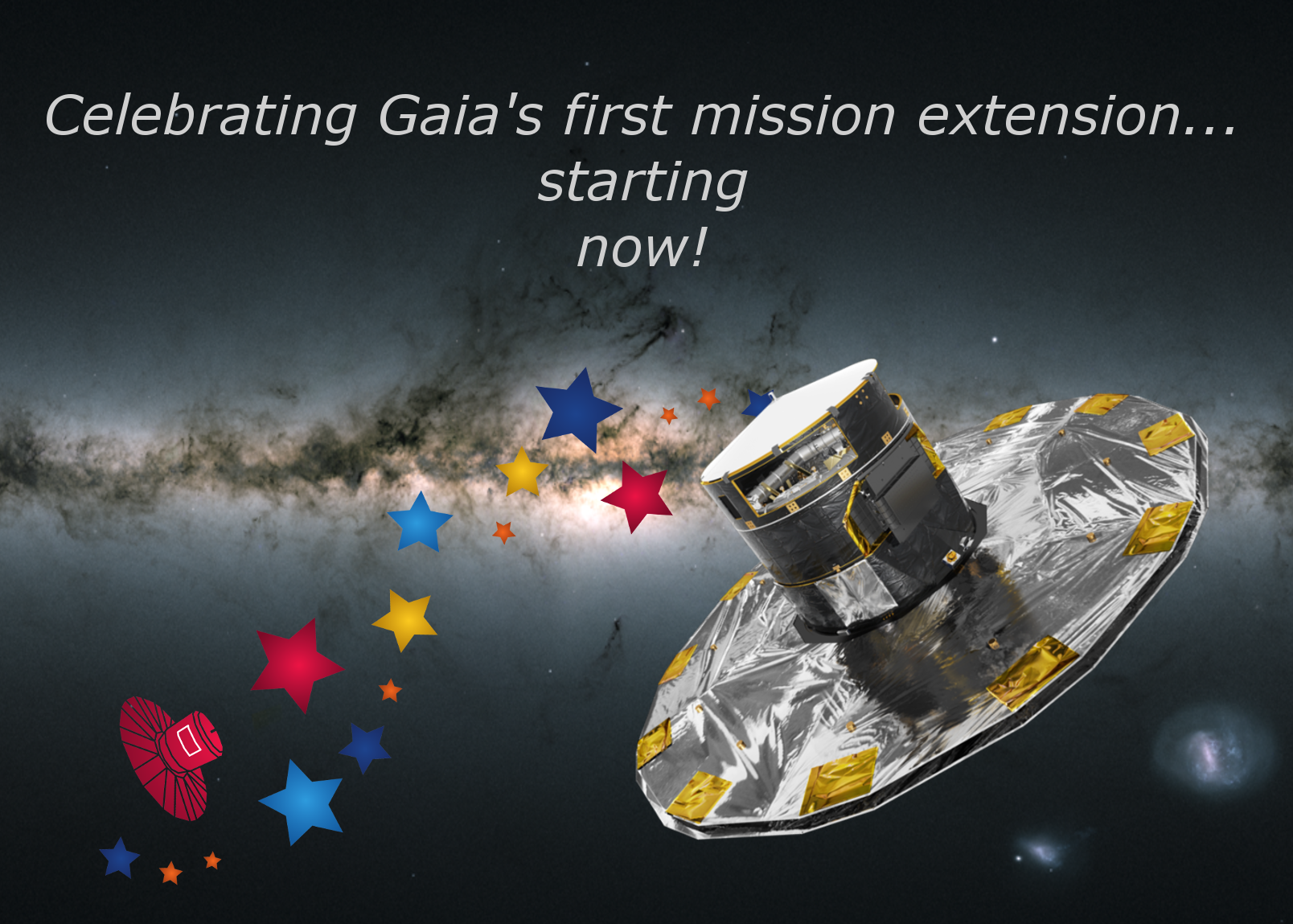
24/06/2019 NWO Spinoza prize for our Gaia DPAC member Amina Helmi
The NWO Spinoza Prize, which is the highest award in Dutch science, was awarded to several researchers working in the Netherlands who belong to the absolute top of science and have done groundbreaking research. Amina Helmi is one of the NWO Spinoza Laureates for her work on the Dynamics, Structure and Formation of the Milky Way at the Kapteyn Institute of the University of Groningen. She is part of Coordination Unit 9 in the Gaia Data Processing and Analysis Consortium and participates in the validation of the Gaia data.
23/05/2019 Lorenzoni Prize 2019 for Gaia DPAC member Eloisa Poggio
The Lorenzoni Prize is an award instituted by the Societa' Astronomica Italiana (SAIt) with the sponsorship of "Officina Stellare" (an Italian manufacturing company in the field of design and construction of telescopes and precision opto-mechanical instrumentation for professional applications for scientific research, aerospace and defense) to reward the best scientific article published by a young researcher in the last 3 years.
This year the Lorenzoni Prize was won by Eloisa Poggio, a young researcher that has published the paper "The Galactic warp revealed by Gaia DR2 kinematics". This paper using Gaia DR2 data reveals that the warp of the Milky Way is a gravitationally induced phenomenon. She was awarded with her prize during the SAIt national meeting that was held in Rome on 16 May 2019.
25/04/2019 Geographic contributions to DPAC
Today marks the first birthday of our Gaia Data Release 2, a data release that truly changed our view of the Milky Way. We'd like to celebrate this day with a special thank you to all the people involved in all stages of Gaia's life: from initial proposal, to gathering interest, to design and building and actual operating of the spacecraft. From getting the data down, checking the health of the data, to processing the raw data into a scientifically usable format and then validating to make sure the data is truly that great!
In the image released today you can see the geographic contributions to the Gaia Data Processing and Analysis Consortium. It shows the countries where the people in DPAC are working. Read further on Gaia DPAC and its contribution to Gaia Data Release 2 in our newest story available here.
18/04/2019 Summary of the 53rd ESLAB symposium
From 8-12 April 2019, the 53rd ESLAB symposium took place at ESTEC, The Netherlands. A summary of the results shown at the symposium can be found here.
07/04/2019 Rethinking everything we know about star clusters
Recently an overview article appeared on ESA Science & Technology discussing the role of Gaia in our knowledge of star clusters. By studying stellar clusters, Gaia reveals much about the formation and evolution of stars in our surroundings. Read the full article here.
22/02/2019 Update to the Gaia DR2 known issues
Today an update to the Gaia DR2 known issues was published discussing Gaia DR2 photometry. We advise you to read through this topic if you use Gaia DR2 photometry.
31/01/2019 Update to Gaia DR2 known issues page on radial velocities
Today on ArXiv a paper appeared by Boubert et al. describing potential contamination of radial velocities in crowded regions. A summary has been added to our Gaia DR2 Known Issues page, along with links to the paper and the accompanying data. The page also describes other topics like astrometry and crossmatches, and complements the Gaia DR2 data release documentation.
29/01/2019 Gaia Data Release 3 split into two parts
The Gaia data processing toward Gaia DR3 is progressing at full speed. Although the schedule has stabilised, there are several uncertainties as many elements of the pipelines will see the real data in an operational environment for the first time. Taking the uncertainties into account brought the schedule of the next release toward the end of the earlier announced period of the first half of 2021.
To mitigate the impact on research, the Gaia DR3 will be split into two releases. This way, data that is ready earlier, will be released earlier. The early release, Gaia EDR3, contains astrometry and (integrated) photometry i.e. positions, parallaxes, proper motions, G-band fluxes as well as integrated red- (RP) and blue-band (BP) fluxes, all based on 34 months of data resulting in better accuracy with respect to Gaia DR2. First results for a predefined list of quasars and extended objects may also be included already in the early release. Gaia EDR3 will take place in Q3 of 2020.
Gaia DR3, which is anticipated to take place during the second half of 2021, will supersede Gaia EDR3. This means that the source list and any data published in Gaia EDR3 will not change, but is simply copied to Gaia DR3. Therefore Gaia DR3 is based on the same 34 months of mission data as for Gaia EDR3. The additional products include:
- radial velocities (significantly more due to fainter magnitude limit),
- BP/RP/RVS spectra (new products),
- Solar system data (significantly more sources included),
- variability information (significantly more objects due to longer time interval),
- results for non-single stars (new products), and
- astrophysical parameters (based on spectra).
The final inclusion of the products into Gaia DR3, as well as Gaia EDR3, is subject to successful validation.
|
29/12/2018 Movement of tiny galaxies surrounding the Milky Way New animation shows the movement of tiny galaxies surrounding the Milky Way as described in a recent story. An interactive version is available here. |
|
19/12/2018 Reward for Gaia and Anthony Brown Our Gaia DPAC Chair Anthony Brown is recognised by Nature as one of the 10 people who mattered in 2018. This is a special recognition for Anthony, who keeps the Consortium moving forward to get the data from our Gaia mission out to the community. Read the article here |
|
17/12/2018 Video release: the universe of Gaia Gaia was launched 19 December 2013 and has been scanning the sky ever since. Our second data release, published this April, provided scientists with an extraordinary data set to investigate the formation and evolution history of our Milky Way. Hundreds of scientific studies were performed since, with new papers coming out almost every day. Video credits: ESA/CNES/Arianespace; ESA/Gaia/DPAC; Gaia Sky / S. Jordan / T. Sagristà; Kppelman, Villalobos and Helmi; Marchetti et al. 2018; NASA/ESA/Hubble; ESO, M. Kornmesser, L. Calçada |
|
14/11/2018 Gaia mission extension approved Today the ESA Science Programme Committee (SPC) confirmed the Gaia mission extension for mid-2019 to end of 2020 and has given an indicative extension for up to end of 2022. More information can be found here. |
|
02/10/2018: Gaia spots stars flying between galaxies A team of astronomers using Gaia Data Release 2 looked for high-velocity stars being kicked out of the Milky Way were surprised to find stars instead sprinting inwards – perhaps from another galaxy. Read the story here. |
|
19/09/2018 Gaia hints at our Galaxy's turbulent life Research using our Gaia DR2 data has shown our Milky Way galaxy is still enduring the effects of a near collision that set millions of stars moving like ripples on a pond. Read the story here. |
|
27/08/2018 Gaia DR2 Known Issues A new page dedicated to discuss some known issues with the Gaia DR2 data is available here. These cover issues that are important for the users to be aware of but that were only discovered after the release of the data and the documentation. Keep an eye out for the page as newly found issues will be published there when needed. |
|
22/08/2018 Infant exoplanet weighed by Hipparcos and Gaia An article published in Nature Astronomy discusses the use of Gaia Data Release 2 in combination with Hipparcos data to estimate the mass of the young exoplanet Beta Pictoris b through the astrometric motion of its host star. Read more here. |
|
17/08/2018 A&A special edition on Gaia Data Release 2 out The A&A special edition on Gaia Data Release 2 is now out and can be found here. Gaia DR2 papers are also summarised on this website with added links to access the papers. |
|
25/04/2018 Gaia DR2 release day Today we released our our second batch of data. Many thanks to all the work of the people involved in Gaia! Information on the papers describing the data processing and the science potential of Gaia DR2 can be found here. Now there are some in-depth stories on the data release are available, as well as a guide to scientists to help you get up to speed with using Gaia DR2. Many images and stories were released today: Gaia creates richest map of our Galaxy and beyond, Gaia's sky in colour, Gaia's Hertzsprung-Russel diagram, Cosmic scales covered by Gaia's second data release, Large Magellanic Cloud, Small Magellanic Cloud, Gaia's view of more than 14000 asteroids, Gaia's globular clusters and dwarf galaxies, Gaia's globular clusters and dwarf galaxies - with orbits, Gaia's new map of star density, the Galactic sensus takes shape, Rotation of the Large Magellanic Cloud. Many more are expected from the science with Gaia data release 2. Make sure to watch the 360 degrees Gaia first sky map in colour with your smartphone and Google cardboard! |
|
20/04/2018 Gaia DR2 media kit available now The media kit for our second Gaia data release is now available. Today also two stories were published on the results from Gaia data release 1. Read about Gaia's surprising discoveries: from the Sun's neighbourhood to the distant universe and Gaia's surprising discoveries: scrutinising the Milky Way. |
|
14/04/2014 Gaia tops 100 billion star transits Today the Gaia main database indicated that we topped 100 billion star transits through the focal plane. With celebrate this event with a dedicated image of the week. An overview of the total amount of observations taken is available on this page. |
|
05/04/2018 Precise object counts for Gaia Data Release 2 Ever wondered how many sources we will release exactly in Gaia DR2? No need to keep guessing, exact object counts were just released here. More information can also be found in the news item by ESA Science & Technology. |
|
03/04/2018 The cat in Orion... What do you seen when looking at this week's Space Science Image of the Week? A cat, a fox or even a shark?
|
|
21/03/2018 Gaia status update Last month, ESA's Gaia satellite experienced a technical anomaly followed by a 'safe mode' event. After thorough examination, the spacecraft was successfully recovered and resumed normal scientific operations, while the mission team keeps investigating the exact cause of the anomaly. More information can be found here. |
|
16/03/2018 Latest releases of GOG and GUMS Gaia Object Generator 18 is now available also in HDF5 through this web page. Also a new version of the Gaia Universe Model Snapshot (GUMS-18) is now available from OBSPM. More information on Gaia tools can be found here. |
|
16/03/2018 Release of the draft Gaia DR2 data model and passbands To help scientists prepare for our second data release, a draft of the Gaia DR2 data model is provided for download along with some updates on the upcoming release. Available for download as well are our Gaia DR2 passbands. These are featured in our image of the week.
|
|
29/11/2017 Visualisation of a selection of asteroids detected by Gaia Coordination Unit 4 of the Gaia Data Processing and Analysis Consortium is responsible for the processing of non-single stars, Solar System objects and extended objects. Gaia Data Release 2 will contain epoch astrometry for more than 13,000 known asteroids. The visualisation of these asteroids as detected by Gaia has just been published by ESA Science & Technology. |
|
17/11/2017 How do you find a star cluster? On 15 November a story was published on the ESA Science & Technology website called "How do you find a star cluster? Easy, simply count the stars". A story on the discovery of the first Gaia cluster: Gaia 1. |
|
02/10/2017 Extra stars to help out the Triton occultation campaign In order to facilitate earlier conducted Triton campaigns from September, we provide preliminary astrometry for an additional 334 stars available for download through the links below: When using these data, please follow the acknowledgment and citation guidelines as given here. Good luck with the observations! |
|
30/09/2017 Gaia mission helps with Triton occultation observations On Thursday 5 October an important and rare astronomical event will take place: Triton will be occulting a star (called UCAC4 410-143659 or GaiaDR2 2610107907030969600). This stellar occultation will be visible from Europe across the Atlantic to the USA. A predicted occultation path has been computed using the preliminary Gaia DR2 position and proper motion for this star. The Triton position can, however, still be improved. In order to maximise the scientific output of the occultation event, we have decided to release astrometry for 119 stars in the field surrounding Triton at this moment. The most suitable stars between magnitudes 12 and 17 have been chosen for astrometric calibration purposes. Please note that full validation of the data is not yet done and therefore some caution is required when interpreting the results. Nevertheless, we believe the data will allow improvement of the occultation prediction. Scientists using these data to improve Triton astrometry are encouraged to make their deduced positions public so that science return can be maximised for all groups observing the event. Please keep us informed of your efforts and results in this topic. The 119 stars are available for download through the links below: When using these data, please follow the acknowledgment and citation guidelines as given here. Good luck with the observations! |
|
14/09/2017 First birthday of Gaia Data Release 1 Exactly one year ago, we released our first data. Since the release, more than 170 refereed science papers used the Gaia DR1 data so far. If you are interested to check out any publications on Gaia, please have a look here. |
|
31/08/2017 Press releases on close stellar encounters Today several videos were released by ESA to accompany the press release "Close encounters of the stellar kind". Our image of the week item on this topic can be found here. Enjoy! |
|
30/08/2017 Interview with Lennart Lindegren kicking off the Gaia Science Meeting in Lund. Today a three-day meeting called "The science of Gaia and future challenges" kicks off in Lund, Sweden. Home of the Lund Observatory, an institute involved in the Gaia Data Processing and Analysis Consortium (DPAC). The meeting also coincides with the retirement of Lennart Lindegren, one of Gaia's important faces. Here is in interview with him to start off this meeting with some in-depth knowledge on Gaia's history and Lennart's role in all of this. Thank you, Lennart, for your huge contribution to the Gaia mission and we are happy you will keep on working with us! |
|
30/06/2017 Asteroid Day On Asteroid Day we would like to draw your attention to the Gaia Follow-Up Network for Solar System Objects (FUN-SSO). About 600 potential discoveries of Solar System Objects have been reported up till now. Anyone at the right place on Earth at the right time with the right size of telescope can help confirm these potential discoveries. A list of active alerts can be found here. If you subscribe to the network, you can enter your location and telescope details. There is an active call at the moment for following-up on a candidate! Grab your chance and be the first to confirm! |
|
23/06/2017 Two Arthur C. Clarke Awards for Gaia teams We are proud to announce that our Gaia teams won two Arthur C. Clarke awards, also known as Arthurs. The Industry/Project Team award went to Airbus Defence and Space "For the successful design and manufacture of the Gaia spacecraft and telescope which for the last 3 years has been accurately measuring the location and motion of the stars”. The second award was given to the UK Gaia Science Team. They won the Space Achievement - Academic Study/Research award "For its role in processing and analysing data from the Gaia star mapping mission as its contribution to the European Data Processing and Analysis Consortium”. This latter award was presented by UK/ESA Astronaut Tim Peake to Gerry Gilmore (UK Gaia PI), Martin Barstow and Simon Hodgkin, who received it on behalf of the wider UK team. The award is made of glass, and is based on the monolith in Clarke’s 2001: A Space Odyssey, with the same proportions (1:4:9). |
|
09/06/2017 Future of the Orion constellation A new video on the future of the Orion constellation was just released by ESA Science & Technology. It shows the movement of the stars in the sky for the coming 450,000 years, based on TGAS data. This a subset of Gaia DR1 consisting of those stars in the Hipparcos and Tycho-2 Catalogues for which a full 5-parameter astrometric solution is available. In April another video was published showing the movement of the stars in the entire sky. |

